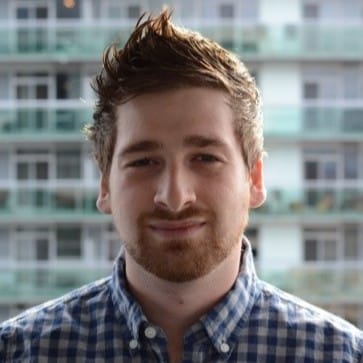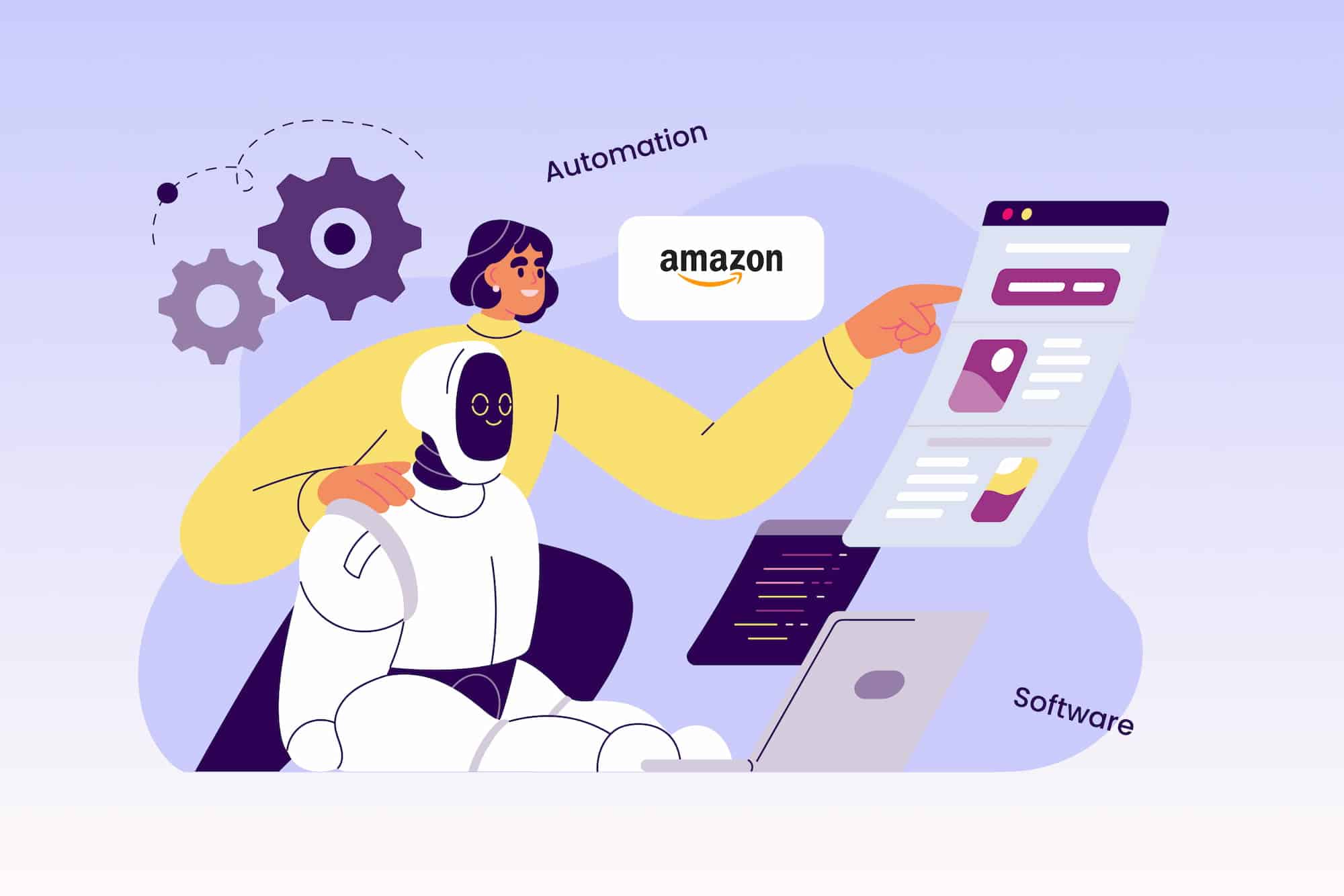Virtually all brands rely on marketing to stand out from the crowd, whether that means SEO strategies or a skillful use of promotions. Beyond these methods, many look to achieve marketing success via reliance on pay-per-click, or PPC, advertising.
While PPC campaigns can be handled manually by those well-versed in the skills needed to run them, the consistent, data-driven algorithms within software make it much easier. These are the nine best Amazon PPC automation software platforms and the ways you can make them work for you and your business goals.
-
- Trellis
- PPC Entourage
- Scale Insights
- Sellozo
- Quartile
- Teikametrics
- Perpetua
- Pacvue
- PPC Ninja
The 9 best Amazon PPC advertising softwares
1. Trellis

With coveted Amazon Advertising Partner approval, Trellis is one of the biggest names in Amazon seller tools in general—and this includes an expert approach to Amazon PPC advertising. Our software goes beyond PPC automation and optimization and is able to support advertising goals in a comprehensive manner while still providing extensive support for Amazon sellers in a multifaceted way.
Our platform takes the guesswork out of eCommerce advertising, providing tools to target customers at all stages of the purchasing funnel.
Trellis connects keyword harvesting and bid management with other optimization features like:
-
- Dayparting,
-
- Negative keyword implementation,
-
- Product categorization,
-
- A multi-match type campaign structure,
-
- Repeat purchase, LTV, and HALO product data.
This yields a more robust approach to marketing than more straightforward automation tools ensuring consumers are always in line of sight. The software is flexible and customizable, ensuring that typical advertising goals are achievable, no matter where priorities lie.
Pros
-
- Easy to scale to meet growing business needs.
-
- Sophisticated AI tools to guide, automate, and optimize the use of PPC campaigns.
-
- Robust suite of advertising resources, going above and beyond simple PPC support.
-
- Offer in-depth managed services to support the use of the platform.
-
- Integrates with other adjacent PPC activities like Dynamic Pricing, Content optimization, and promotions forecasting.
Cons
-
- Value is best for those with higher ad spend and larger product lines rather than smaller businesses just starting out with PPC.
Key features
-
- Keyword harvesting,
-
- Daily bid adjustments,
-
- Dayparting,
-
- Catalog categorization,
-
- Data on repeat customers, LTV, and HALO products.
2. PPC Entourage

A PPC tool provided by marketing leader Carbon6, PPC Entourage is a resource to optimize and expand brand exposure via PPC advertising. Bulk management is the name of their game, allowing users to build and expand campaigns over 20 modules in a matter of minutes. Changing products en masse is a big part of these abilities, giving sellers the opportunity to effectively update campaigns quickly. Its interface gives users access to numerous forms of in-platform reporting to see and analyze real-time stats on success rates and potential areas for improvement.
While costlier than some other alternatives, this platform claims to make up just 2.9% of most users’ average spend and has no minimum charge.
Pros
-
- Clean, simple, and well-organized interface.
-
- Flexible pricing with no minimum cost, allowing users to sign up and start designing campaigns without a big initial investment.
-
- Easy editing of bids and targets within the dashboards; no need to visit Amazon’s Campaign Manager.
Cons
-
- This platform can be pricey for those running a high volume of campaigns, as there’s no static subscription cost; thus, cheaper options are available.
-
- It still requires human-built logic and rules as it isn’t a fully automated platform.
Key features
-
- Bulk management across different campaigns,
-
- Straightforward automation tools,
-
- In-platform reporting for accurate performance stats.
3. Scale Insights
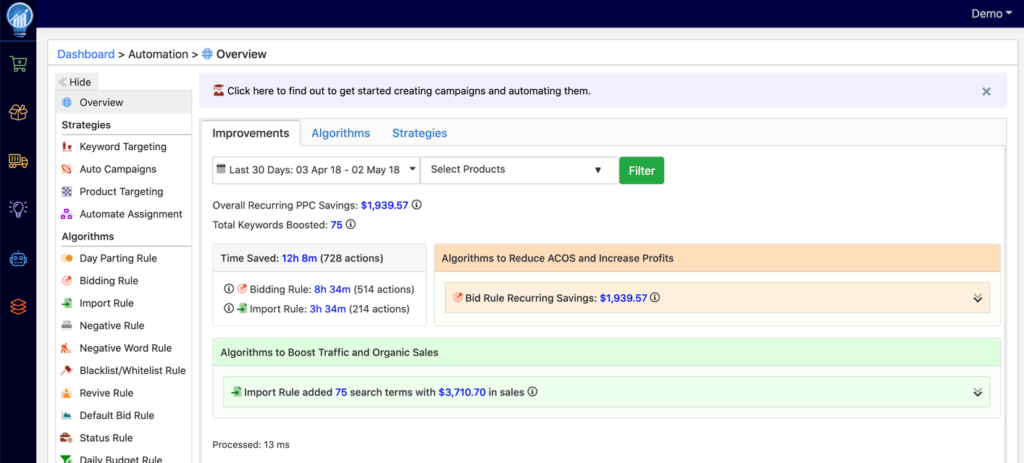
Scale Insights is a little newer to the market than some of the other software on this list, but with an expansive arsenal of tools, this platform promises to help users easily “automate and dominate” in the Amazon PPC space. Flexible and dynamic, the features offered by Scale Insight include real-time bidding based on best-performing ACoS and user-provided rules to ensure goals are met.
Driven by big data and cutting-edge AI technology, Scale Insights is able to detect high-converting keywords to make valuable bidding decisions in a rule-based manner. In addition, the data provided includes reporting on the correlations between PPC, promotions, and organic sales, as well as real-time updates into things like advertising costs, ROI, and margins on ad spend.
Pros
-
- One size fits all solutions, with opportunities for first-time sellers and large agencies alike.
-
- Campaign assistance driven by AI, guiding high levels of automation and optimization.
-
- 30-day free trial for one ASIN in one country for maximum exposure to the tool’s potential.
Cons
-
- Steep learning curve; this platform’s robust options and rule-based automations mean learning the ropes can require some time and effort.
-
- Costs can be high for those starting out; campaigns across five ASINs start at $78 per month.
Key features
-
- Fully managed, bulk auto, and keyword-driven campaigns,
-
- 11 Proprietary “Scale-matic” algorithms, including dynamic bidding, import, and negative word analysis,
-
- Automation that includes strategic objectives, previewing actions, and full visibility.
4. Sellozo
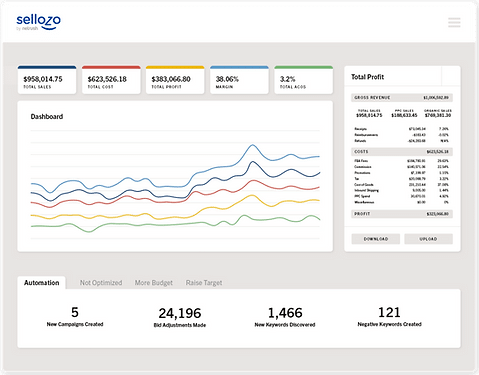
An Amazon Ads Advanced Partner, Sellozo claims to be able to drive a 70% increase in ad profit in just eight weeks—the kind of growth virtually all businesses are looking for. Like many other PPC automation tools, this platform relies on its robust and proprietary AI algorithms to keep users at the forefront of a wide range of Amazon ad campaigns.
Sellozo has four primary objectives to guide sellers: increasing sales, lowering ACoS, increasing profits, and automating campaign optimization. With this all-in-one tool, complete with a drag-and-drop interface and automated keyword harvesting, it’s possible to define and refine any approach to PPC campaign structure in minutes.
Unlike some competitors in the space, Sellozo boasts flat fee pricing rather than a percentage of ad sales, keeping costs affordable for those doing high volumes of business.
Pros
-
- Easily import existing campaign information.
-
- Campaign creation can be achieved in a few easy clicks.
-
- Pre-made campaign templates for easy design.
Cons
-
- Limited integration into other platforms.
-
- Percentage fee-based models might be more affordable for smaller operations.
Key features
-
- Full PPC management,
-
- Complex campaign modeling and creation with Campaign Studio,
-
- Cross-campaign implementation and launch optimization,
-
- Negative keyword automation.
5. Quartile
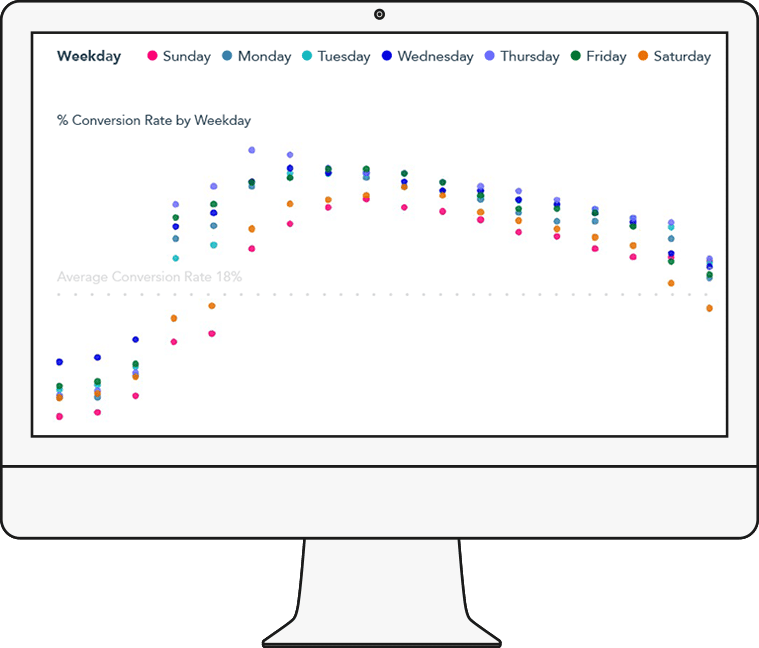
For big brands with big goals, Quartile can be a good way to take an ad game to the next level. By using six unique patented technologies that can integrate thousands of critical customer touchpoints, all users need to do is set goals, and Quartile can do the rest.
With compatibility across all major marketplaces, productivity doesn’t stop with Amazon. Running cross-channel marketing campaigns can be managed using this one platform, streamlining the use of tools and saving time and money. And, with unified measurement and attribution reporting, it’s possible to identify what’s helping your campaigns succeed and where improvements are needed.
Like others on this list, Quartile charges based on ad spend but promises no charges for commissions or add-ons.
Pros
-
- Six patented tools that provide unique services.
-
- Potential to see conversion rates and revenues grow as much as +30%.
-
- Access to dedicated customer service teams to immediately address issues.
-
- Campaigns driven by a customer’s identified goals.
Cons
-
- No free trial or free version of the tool.
-
- Strategies may be somewhat outdated compared to some of the newer platforms on the market.
Key features
-
- Unified campaign reporting,
-
- Blend retail and digital media campaigns,
-
- Hands-off managed solutions,
-
- Sophisticated machine learning.
6. Teikametrics
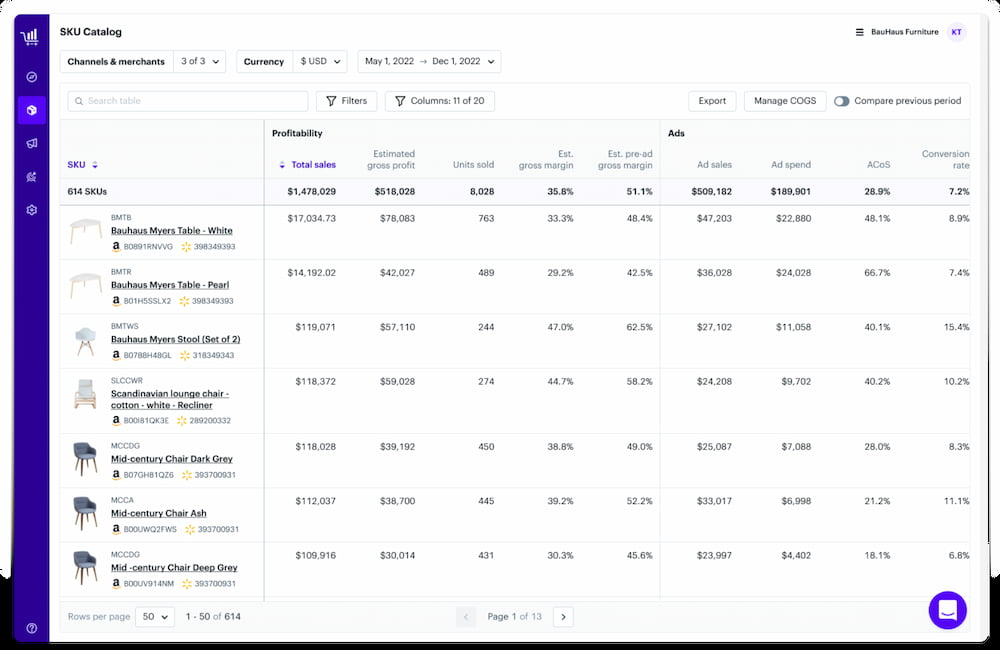
With the ability to connect products, advertisements, and marketing objectives, users can tackle many facets of the PPC campaign process through Teikametrics. This includes targeting and bidding. Track performance and make tweaks to campaign goals to grow revenue and reduce ACoS. Users can also use this tool to improve product margins, analyze lifecycle stages, improve conversion rates, and formulate bids to stay on top of campaign success.
Pros
-
- Available on Amazon as well as other marketplaces like Walmart.
-
- Results-driven ad management opportunities.
-
- Advanced KPI analysis to understand what’s working in campaign strategies.
Cons
-
- Higher price point than some of the competition; pricing tiers are based on intended ad spend, with high monthly costs for those with big budgets.
-
- Their main focus is on advertising, limiting the types of AI-optimizations they can provide.
Key features
-
- AI-powered advertising platform with Amazon Flywheel 2.0, a proprietary automation tool,
-
- Optional managed ad services,
-
- Connected multichannel performance,
-
- SKU-level analytics.
7. Perpetua

Perpetua’s main workflow centers around objectives, like growth goals, profitability targets, brand defense, or market awareness, and uses these inputs to create optimized campaigns aimed at achieving benchmarks strategically. Once Perpetua is up and running, all users need to do is set target ACoS and daily budgets, and the automated tools will do the rest.
The basic functions outside of this approach are similar to what other services can provide, including adjustable AI bids depending on inputs. Metrics are available on an hourly basis, allowing users to dig deep into what’s working and when. This can allow for flexibility in strategies, whether, for example, share of voice matters most or growth goals are a primary focus.
Pros
-
- Time-saving tools can free up advertising management commitments.
-
- Goal-targeted ad campaign creation for tangible results aimed at meeting objectives.
-
- Free access to basic tools, like Perpetua’s benchmarker resources, that can identify growth opportunities in seconds.
Cons
-
- High price points that may be out of reach for newer sellers or those with limited needs,
-
- Can be difficult to drive goals when the issues lie outside of the scope of advertising as this platform isn’t well integrated with pricing, content, and deal functionality.
Key features
-
- Marketplace advertising optimization,
-
- Display advertising resources,
-
- Video advertising tools,
-
- Market intelligence reporting and analytics.
8. Pacvue
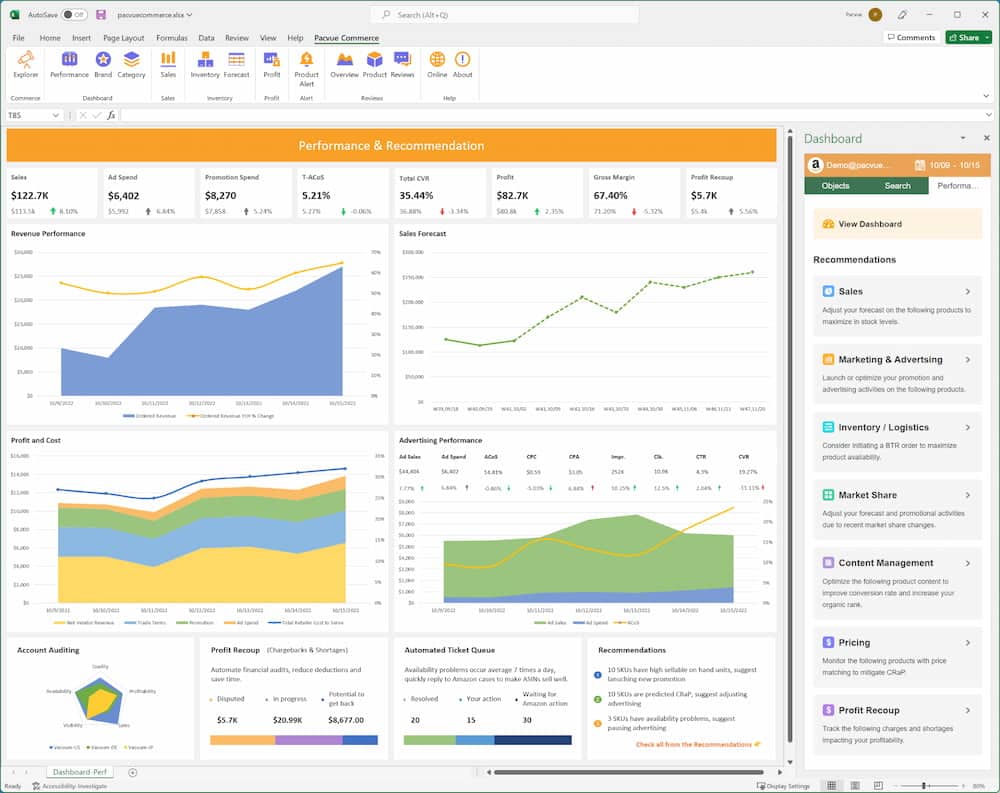
Unlike many of the other tools on this list, Pacvue is a more comprehensive Amazon seller resource without a specific focus on PPC campaign creation or Amazon. This can be something of a double-edged sword; sellers who need more than solely Amazon PPC assistance will love the suite of features, but specialized and targeted resources are somewhat lacking as this isn’t the platform’s sole purpose.
The media activation services will be most valuable for sellers with automated marketing strategies in mind. The cross-marketplace approach means streamlined workflows across Amazon and numerous other marketplaces, improving resource allocation. Automation can be implemented at customizable levels; sellers can lean on rule-based logic to create their own strategies or use the Precision AI tool to scale their campaigns. This can allow for strategy recommendations and templates to use, as well as tools like budget management.
Pros
-
- Expansive resources that go well beyond simple PPC management.
-
- Full suite of features to target all aspects of advertising optimization.
-
- AI solutions, as well as customizable campaigns based on recommendations.
Cons
-
- Without a specific focus on PPC advertising, options may not be as specific or precise as more targeted alternatives.
-
- The sheer size of the platform might make it difficult for smaller teams to adopt.
-
- High cost associated with the robust nature of the platform.
Key features
-
- Rule-based logic to optimize advertising,
-
- Bid, targeting, and budget customization,
-
- Templates for dayparting and budget management,
-
- Keyword and phrase research tools.
9. PPC Ninja
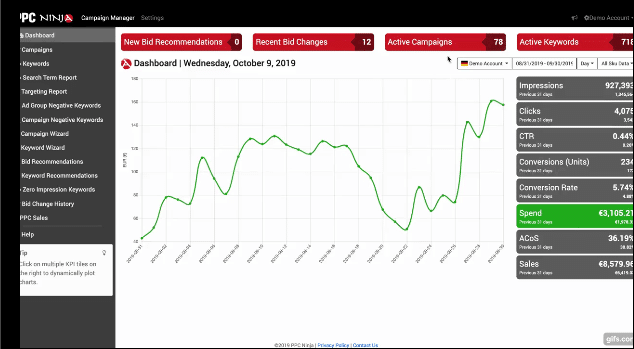
PPC Ninja has long been a favorite for advertisers with straightforward PPC objectives, and for good reason. While most platforms utilize machine learning to guide campaigns, PPC Ninja uses a recommendations-based optimization strategy. This includes everything from keyword suggestions to campaign construction. Rather than relying on what a program puts into motion, users can act on the suggestions that resonate most with their objectives. This won’t be ideal for everyone, but for brands who’d prefer a little more control, this can be the perfect solution. The Excel-like interface will make users feel right at home, too. Managed services are available, though they don’t necessarily compare to more sophisticated tools.
Pricing is based on the number of SKUs being used to create campaigns, so how much users spend depends on how much marketing is needed to achieve goals.
Pros
-
- Bulk campaign operations.
-
- Daily bid optimization to make it easier to hone strategies in real-time.
-
- Keyword suggestions based on ongoing performance.
Cons
-
- For brands who want a hands-off approach, PPC Ninja may require too much manual work to be truly effective.
-
- Less robust than competitor experiences.
Key features
-
- Bid sufficiency model,
-
- No bots in use; control is in the user’s hands,
-
- Multi-level Target ACoS based on accounts, SKU, campaigns, and branded keywords.
The main benefits of Amazon PPC automation software
There are many benefits to Amazon PPC automation programs, ranging from increasing the success rates of campaigns to saving on ad spend. Here are some general advantages users can expect, regardless of overall business objectives:
Save time
Managing PPC campaigns can require a lot of heavy lifting, particularly if you have a large inventory of products. While theoretically possible to handle manually, this can eat up plenty of time each week, taking away from other important endeavors. With automation software, you can put the burden on your Amazon support platform, freeing up your focus to devote to other business purposes.
Campaign creation can be incredibly time-intensive, especially for those new to the process. This is one of the biggest benefits of these kinds of support tools; since many software products of this kind are designed around a “set and forget” methodology with some basic instructions, you can reallocate the time saved into other marketing efforts.
Increase profitability
The success of PPC campaigns relies heavily on the strategies sellers know and implement, but, unfortunately, most people aren’t experts in determining what works and what doesn’t. Amazon PPC management software makes the likelihood of successful campaigns higher, as you have more than your own intuition to rely on. These platforms can optimize keyword use and maximize your budget, cutting your spending while increasing success rates—in short, PPC software provides a formula to boost profitability without reducing your outcomes. When you want to make every dollar of ad spend work for you, automation software can help you reach your goals.
Increase market share
Part of the beauty of PPC campaigns is expanding reach and branching out into new markets. It doesn’t hurt that this takes market share away from the competition, too. The best Amazon PPC tools make it possible to focus on becoming a leader in the market rather than another voice in the crowd.
When PPC campaigns are optimized in the right way, consumers will be better positioned to see your brand listed above the competition, putting eyes on your products before anyone else’s. Dynamic and optimized bid management can yield impressive results, ensuring every dollar of your budget will go toward taking your brand to the top, paying close attention to what shoppers are searching for.
Improve decision making
Most businesses know what they’re trying to accomplish—growth in revenue, lower ACoS, or better margins, for example—but don’t necessarily know how to get there. This is where Amazon PPC automation software can become a significant benefit.
The advanced AI used to support these kinds of resources is programmed based on a huge array of data, meaning that automated campaigns are poised to make the right decisions in seconds. This can take the pressure off of your operations as well as help your team to learn and grow in the advertising space, providing the kind of knowledge that only comes with experience. Learn what drives successful campaigns, align automated performance with your goals, and explore the many ways you can work to get ahead of the competition.
What to look for in Amazon PPC automation software
Amazon PPC automation software comes in many different forms, which is a benefit for sellers since every company has different needs. Regardless of the sales strategies your business favors, these are some of the most important things to keep in mind when evaluating your options:
Features
The features an automation software offers should be at the center of your research. You want tools that can meet your objectives head-on rather than being stuck with useless resources or software you don’t know how to use effectively. While specific needs will vary from one brand to another, these are some of the most important features to look for when evaluating PPC automation products:
-
- Keyword research tools and harvesting functions.
-
- Advanced budget management, including the ability to set daily limits and ACoS reduction resources.
-
- Multi-marketplace support if you sell outside of Amazon.
-
- Comprehensive analytics dashboards and other reporting tools that can display the metrics you need most.
-
- Automated bid management.
-
- Automated campaign creation. Or, if preferred, the use of recommendations to help guide a more manual decision-making process.
-
- Free trial period or access to a comprehensive demo to ensure understanding of a product and its key functions.
-
- Robust customer support that can address issues immediately.
-
- Training and resource tools to guide overall product understanding.
-
- Costs in line with platform opportunities and offerings.
-
- Extendability of the platform beyond PPC to further optimize.
Ease of use
When spending money on something as significant as PPC campaigns, you want to be sure you’re able to make the most of the tools in front of you. Some programs are clunky, hard to understand, or full of bells and whistles that bog down key functionality. If you’re stuck with this kind of software, it’s far easier to make mistakes or fail to optimize your campaigns effectively.
While evaluating products, keep the ease of use in mind, particularly regarding the functions you rely on most. After all, if you can’t figure out how to get from Point A to Point B, it’s unlikely you’ll be able to take full advantage of your investment in a chosen Amazon PPC automation software.
A free trial period or hands-on demo can be a good way to assess products in this regard; with time to play around before making a commitment or getting a walkthrough from a pro, it’s much easier to feel confident in the abilities of a particular platform.
Reporting
The promises an Amazon PPC software makes mean nothing if you can’t see tangible proof of improvements. Instead of trusting marketing material on what a product can do, reporting can help you see for yourself what you’re getting for your investment.
Reporting can look different across various platforms, but at the end of the day, you want something easy to use and customizable to suit the KPIs that are most relevant to your brand. Drag and drop dashboards can be particularly valuable, as they’re generally simple to adapt to and possible to customize to put the metrics you need right at your fingertips. Downloadable data can be key as well, especially for sellers who plan to incorporate PPC reporting stats into other company databases.
Price
Regardless of your objectives, buying Amazon PPC management software is an investment—and one that can easily play a role in your ability to maximize profits.
-
- Pricing for Amazon PPC products tends to work in one of two ways: flat subscription fees or commissions based on ad campaigns.
-
- Which model will work best for you can be highly variable; bigger operations with lots of SKUs in use are often most satisfied with fee-based billing, while smaller companies without robust needs might be happier with paying per SKU in use.
-
- Subscriptions with one set monthly or annual expense can be a sign of more comprehensive tools, too, so if a platform is only charging based on campaigns in use, there’s little likelihood that it offers additional tools to support Amazon sellers.
Ensure you’re not cutting corners on functionality for the sake of saving money. Some services that charge low prices may be doing so because they’re offering poor services.
Data
While reporting tends to refer to how accessible information is and how it can be used to drive decision-making, the use of reporting truly relies on the availability of needed data. The data a platform collects and presents can be very important in campaign optimization; if the KPIs your company needs aren’t available, there’s no way to see if specific company goals are being met.
Before choosing a service, it’s best to know what metrics you’re most interested in, as well as perform a full analysis of what may be available. Those new to PPC advertising on Amazon may not know what’s necessary without seeing a full list of what data is collected and how it’s presented.


